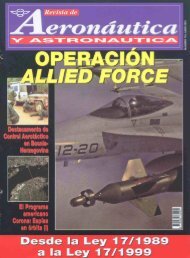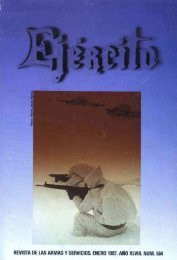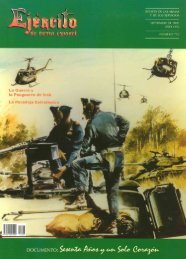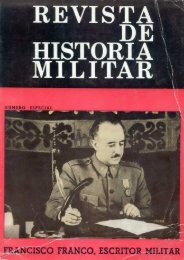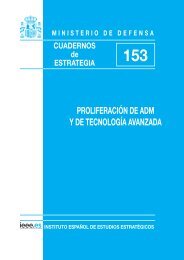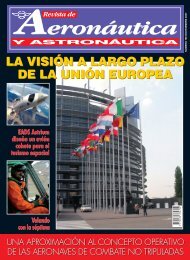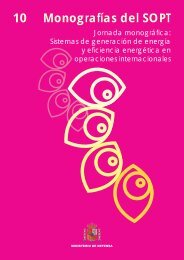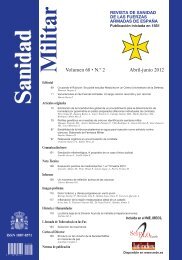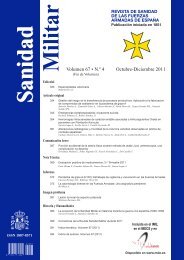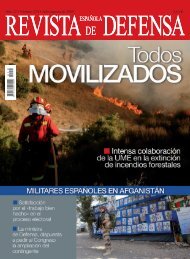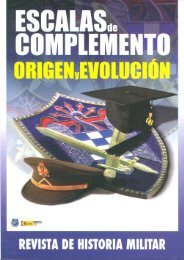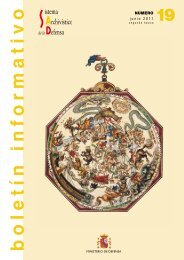Sanidad Militar - Portal de Cultura de Defensa - Ministerio de Defensa
Sanidad Militar - Portal de Cultura de Defensa - Ministerio de Defensa
Sanidad Militar - Portal de Cultura de Defensa - Ministerio de Defensa
Create successful ePaper yourself
Turn your PDF publications into a flip-book with our unique Google optimized e-Paper software.
and body mass in<strong>de</strong>x (24 , 4 kg/m2 in drivers compared to 24.4 [SD = 1.9] of the GC) were similar. We found significant differences between<br />
the two groups in the following variables: uncoartrosis (OR = 2.4, P = 0.02), apophyseal osteoarthritis (OR = 2.82, P = 0.02), osteophytes (OR<br />
= 4.26 P = 0.007), loss of vertebral body height (OR = 11.29, P = 0.008) in the cervical region, subchondral irregularity (OR = 2.82, P = 0.02)<br />
in the dorsal region. The mobility of the back (as measured by push-ups in different areas, extensions, rotations and lateralized) was lower in the<br />
fighter pilot. Conclusions: The fighter pilots of our study have a higher stiffness in the spine, as well as early radiological changes, mainly in the<br />
cervical region, compared with a similar GC.<br />
KEY WORDS: Fighter pilot, back pain, neck pain, low back pain, preventive medicine.<br />
BRIEF COMMUNICATION<br />
367 Acci<strong>de</strong>ntal puncture of the iliac artery when pulling back a double J by ureteroscopy, an un<strong>de</strong>scribed complication<br />
Fernán<strong>de</strong>z Medina E., Paños Fagundo EV., Truyols Fernán<strong>de</strong>z C., Del Castillo T.<br />
SUMMARY: the puncture of the iliac artery during an ureteroscopy is a rare complication seldom <strong>de</strong>scribed in the literature but potentially<br />
serious. Ureteroscopy is a safe procedure for diagnosis and treatment of the pathology of the higher urinary tract. We present a clinical case as<br />
a warning not to un<strong>de</strong>restimate any surgical procedure. This case emphasizes the importance of communication among all medical personnel<br />
who participate in a surgical procedure. Finally we wish to draw attention to the laryngeal mask that allowed the efficient ventilation of the<br />
patient during the whole procedure.<br />
KEY WORDS: Ureteroscopy complications, Endovascular prosthesis, Laryngeal mask.<br />
TECHNICAL NOTICE<br />
369 Positive assessment of drugs: 3 er quarter 2011<br />
Prats Olivan P., González Alfonso M., Puerro Vicente M., García Luque A.<br />
SUMMARY: The drugs assessed by the Spanish Agency for Medicines and Health Products ma<strong>de</strong> public in the first quarter of 2011, and consi<strong>de</strong>red<br />
of interest in hospital healthcare professional, are reviewed. These are positive technical reports prior to the authorization and placing<br />
on the market of the product.<br />
KEY WORDS: Drugs, News, 2011.<br />
REPORTS<br />
372 Pan<strong>de</strong>mic of swine flu (H1N1): strategies for surveillance and immunization in the Armed Forces<br />
Cáceres Bermejo GG., Ballester Orcal LE.<br />
SUMMARY: The Armed Forces constitute a group of special interest for the surveillance and the prevention of influenza. The aim of this paper<br />
is to <strong>de</strong>scribe the public health measures taken in response to pan<strong>de</strong>mic of Influenza A (H1N1). Specific protocols of action were <strong>de</strong>signed<br />
for the epi<strong>de</strong>miological surveillance and the vaccination, for national territory and operation areas. The reported cases of Influenza A were<br />
1223 (57,5% in the Army), 10 have required hospitalization, and no <strong>de</strong>ath has taken place. 67800 pan<strong>de</strong>mic vaccines have been distributed and<br />
the coverage reached 9,7 %, the highest coverage of vaccination (45,9%) was obtained in the UME (Emergencies <strong>Militar</strong>y Unit). 613 adverse<br />
effects to the vaccination were reported, but all of them were slight.<br />
KEY WORDS: Armed Forces, Influenza A (H1N1), Epi<strong>de</strong>miology, Vaccination.<br />
375 Forensic <strong>de</strong>ntistry in the Armed Forces: an unresolved matter<br />
Bel Blesa A.<br />
SUMMARY: Forensic <strong>de</strong>ntistry is an emerging discipline in our Armed Forces that answers the needs <strong>de</strong>rived from the Spanish participation<br />
in overseas <strong>de</strong>ployments and NATO agreements. There is still much to be done as far as human i<strong>de</strong>ntification is concerned. The current Dental<br />
I<strong>de</strong>ntification Card is evaluated and a new mo<strong>de</strong>l more in accordance with international standards is proposed.<br />
KEY WORDS: Forensic <strong>de</strong>ntistry, Dental records, Dental chart, Human I<strong>de</strong>ntification.<br />
PICTURE PROBLEM<br />
381 Tumoral lesion of polypoid aspect<br />
Molinero Barranco MA.<br />
HISTORY AND HUMANITIES<br />
383 The evolution of <strong>Militar</strong>y Health in Valencia during the Spanish Civil War (1936-1939)<br />
García Ferrandis X., Munayco Sánchez AJ.<br />
SUMMARY: Prece<strong>de</strong>nts and purposes: After the military insurrection of July 18, 1936 the Republican Army remained partially dismantled,<br />
affecting <strong>Militar</strong>y Health. In case of Valencia, it was assumed rapidly by Sanitary Popular Committee, a revolutionary organism that led the<br />
sanitary response of Valencia to the Civil War. Later, the Republican Government procee<strong>de</strong>d to recover power throghout centralizing measures,<br />
as the militarization of some hospitals. At this the time an authentic <strong>Militar</strong>y Health returned to be articulated. The aim of this work is to study<br />
the evolution of <strong>Militar</strong>y Health in Valencia, one of the most important republican zones. Material and method: Documentation generated by<br />
the abundant hospitals installed in the city of Valencia is analyzed, studying as well changes that took place after militarization of some sanitary<br />
centers. This information has been consulted in the File of the County Council of Valencia. Results: <strong>Militar</strong>y Health in Valencia during the Spanish<br />
Civil War went through several stages, as it evolved from initial improvisation to later organization. Conclusions: A bidirectional relation is<br />
established between the <strong>de</strong>gree of <strong>Militar</strong>y Health organization and troop’s efficiency.<br />
KEY WORDS: Spanish Civil War, <strong>Militar</strong>y Health, militiamen, militarization.<br />
390 Referees for the Revista <strong>de</strong> <strong>Sanidad</strong> <strong>Militar</strong> in 2011<br />
391 Subject In<strong>de</strong>x. Volume 67 (2011)<br />
394 Author In<strong>de</strong>x. Volume 67 (2011)<br />
332 Sanid. mil. 2011; 67 (4)





